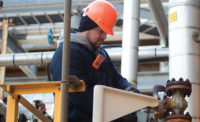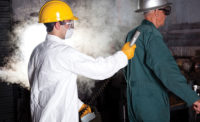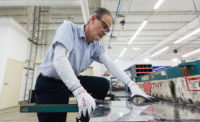Just owning gas detection equipment isn’t enough to keep workers safe or companies in compliance. You need to select the right instrumentation, and know how it works. Effective hazardous gas exposure prevention requires a comprehensive detection program that includes quality instrumentation, proper training, routine calibration, and vigilant exposure monitoring. And to ensure regulatory compliance, you need to thoroughly document and accurately report each of those activities.
No article can tell all there is about gas detection technology. But the information here will empower you to ask informed questions when purchasing equipment, and might lead you to re-evaluate what you use now.
The rules of gas detection
There are many federal, state, and local safety and environmental regulations requiring hazardous gas and vapor monitoring. Two examples are OSHA’s gas monitoring regs, 29 CFR 1910.120 for hazardous material site workers, and 29 CFR 1910.146 for confined space entry. Most (but not all) requirements fall into three categories: personal exposure monitoring; confined space entry; and, ambient air monitoring.Personal exposure monitoring requires detecting toxic gases in an individual worker’s breathing zone. Alarm settings on instruments used to do this generally relate to physical and toxic characteristics of a specific gas. But the American Conference of Governmental Industrial Hygienists recommends measuring exposures by threshold limit values (TLV), such as the 8-hour time-weighted average (TWA) and the 15-minute short-term exposure limit (STEL). OSHA measures, instead, with permissible exposure limits (PELs), some of which are based on TLVs. And NIOSH uses measurements known as recommended exposure limits (REL). Alarms on some monitors are set according to yet another set of limits called "immediately dangerous to life or health" (IDLH). Confined space entry regulations require that air in a confined space be evaluated for the presence of combustible gases before any worker enters the area. Gases detected must be in the Lower Explosive Limit (LEL) range: less than 10 percent LEL is typically considered an acceptable concentration. The space must then be measured for oxygen deficiency or enrichment: 20.9 percent oxygen volume in air is generally considered clean air, 19.5 percent is low, and 23 percent is too high. Finally, OSHA’s confined space regulation requires a test for the presence of specific toxic gases, which must be within defined applicable concentration ranges -typically parts per million (PPM) or parts per billion (PPB).
Ambient air monitoring involves continuous measurement of any workplace air, be it indoors or out, to which workers are exposed. Permanent monitoring systems are normally used for ambient monitoring, though it can be done with portable instrumentation set up to detect the gases you are concerned with.
Instrument types
Single gas meters have become popular for personal exposure monitoring: They are simple to operate, and they are more cost effective than multigas monitors when only one gas need be measured, which is normally the case for personal exposure monitoring applications.Multigas meters, in use for years, have gained sophistication since confined space entry regulations came about. The regs instigated a marriage of advanced microprocessor-based three and four sensor gas detector technology with internal sampling pumps. On some instruments, even integrated data-loggers were combined.
Permanently installed ambient air monitoring instruments -fixed systems- generally have many sensor points connected to a common display, alarm, and calibration control. Any point on the system can be either a toxic gas sensor, a combustible gas sensor, or an oxygen sensor. Older analog systems still serve many facilities, but new digital multiplexed networks can be a more capable and cost effective means of monitoring large areas with multiple point requirements.
Understanding sensor technology
Sensor technology is the foundation of any instrumentation, whether portable or fixed, and the cornerstone of accurate compliance reporting. If your sensor selection is inadequate or inappropriate for the application, then everything else down-stream of the sensor will be compromised.Every sensor has its capabilities and limitations. If you don’t match the capability of the sensor with the requirements of your application, you will exceed the sensor’s limits: That means inaccurate data and premature wearing out of your sensor.
The three most common types of sensors are described below and depicted in the diagrams here.
Understanding these sensing principles is essential to selecting the right sensor technology for your needs and to using it properly.
Electrochemical sensors have traditionally been used for detecting toxic gases and oxygen. These sensors work when a reaction occurs between the target gas and an electrolyte in a solution contained in the sensor. As the reaction progresses, voltage is generated across a cathode and anode, the signal is typically linear, and signal strength tends to be directly proportional to concentration. Sensor life is inversely proportional to time and concentration: Over time, sensor signal strength will diminish. Higher gas concentrations will also work to shorten the sensor’s life. Routine sensor calibration is necessary to compensate for decreased sensor signal output. Solid state sensors are in common use for toxic gas detection, as well as for combustible gases. Whereas electrochemical sensors are more specific to the target gas, solid state sensors are non-specific, and they are capable of detecting a wide range of compounds from PPM to percent volume concentrations. You might also hear these sensors referred to as metal oxide semiconductor sensors. That’s because when the target gas comes in contact with the sensing surface the electrical conductivity properties of the sensor are altered such that resistance through the sensor decreases. It is the resistance differential which is measured relative to a known concentration of calibration gas. Signal output for this sensor is non-linear and inversely proportional to the concentration of the gas. Calibration compensates for a drifting zero point in metal oxide sensors, compared to the loss of span value which usually occurs with electrochemical sensors and catalytic bead sensors. Catalytic bead sensors have long been the backbone of combustible gas detection and are still reliable for certain applications. A glass bead around a conducting wire is the reference element in a "Wheatstone Bridge" electrical circuit, while a platinum coated bead is the active functional unit of the catalytic bead sensor circuitry. When combustible gas comes in contact with the heated platinum a combustion reaction occurs at concentrations below the LEL due to the presence of the catalyst. The heat of combustion results in expansion of the metal wire increasing conductance, therefore sensor signal output is linear and proportional until the gas mixture becomes too rich and the upper explosive limit (UEL) is exceeded resulting in a false negative reading on the meter. Halogenated hydrocarbons tend to poison this sensor by creating metal salts and binding the catalyst. Also certain compounds such as lead will have a negative effect on the sensor. Because the catalyst will eventually become bound and unavailable, the sensor’s life span is limited.
Other widely accepted sensing technologies include flame ionization detectors, photo ionization detectors, and dual beam non-dispersive infra-red sensors. Infra-red sensing has become very cost-effective for a limited list of toxic and combustible gases, carbon dioxide being the most popular of those. Infra-red sensing is advantageous for its specificity, calibration stability, and long sensor life. Flame ionization and photo ionization technology are more commonly used to comply with environmental regulations, although these types of instruments are applicable for some OSHA compliance too.
Calibrating your monitor
Federal, state, and local regulations mandate that users calibrate instruments. This is done by delivering a known concentration of gas to the instrument to verify that the sensor is performing within acceptable parameters. If there is a discrepancy between the value printed on the calibration gas bottle and the meter display, the unit should be properly "zeroed" and "spanned."Clean ambient air should contain 20.9 percent volume oxygen, 0 percent LEL combustible gas, and 0.0 PPM toxic gas. Zero air calibration gas is available from most instrument suppliers. Once the zero point is established, then a "span" concentration is applied and the sensor display is adjusted to reflect the appropriate concentration of gas. You must document all calibration activities.
Don't forget to train
Begin with a job-specific hazard awareness program when training workers to use gas detection equipment. Identify each area of the work environment that requires monitoring. Then develop specific procedures to ensure monitoring activities and instrument operation are consistent.It is also wise to develop recordkeeping forms to keep careful track of all training, monitoring, and calibration activities related to your gas detection monitoring program: When the regulators come knocking you will need documentation to show that you have done it right.


